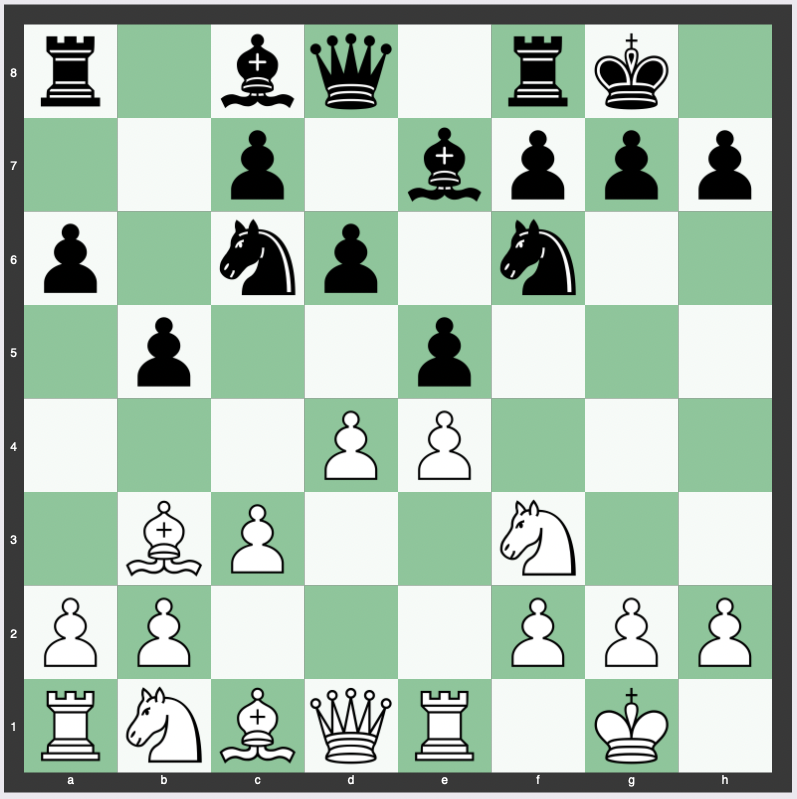The Yates Variation is a fascinating and complex line within the Ruy Lopez, one of the most popular and enduring chess openings.
Here we look at the Yates Variation in detail, delving into its move order, theory, strategy, and purpose, as well as its variations, history, suitability for different levels of players, and its frequency of play at the Grandmaster level.
We’ll also cover the Bogoljubow Variation (9…Bg4) and Yates Variation, Short Attack (9…Bg4 10.a4).
Move Order of the Yates Variation of the Ruy Lopez
The Yates Variation follows the sequence 1. e4 e5 2. Nf3 Nc6 3. Bb5 a6 4. Ba4 Nf6 5. O-O Be7 6. Re1 b5 7. Bb3 d6 8. c3 O-O 9. d4.

This move order sets the stage for a rich middlegame, with opportunities for both sides to demonstrate tactical and strategic prowess.
Theory, Strategy and Purpose of the Yates Variation
The Ruy Lopez aims to control the center and create opportunities for piece development.
The Yates Variation specifically focuses on central control and potential kingside attacks.
The move 9. d4 is aggressive, challenging Black’s central pawn structure and opening lines for the pieces.
Sub-Variations of the Yates Variation
Two notable variations arise from the Yates Variation:
- 9…Bg4 (Bogoljubow Variation): This move pins the knight to the queen, creating counterplay and tension in the position.
- 9…Bg4 10.a4 (Yates Variation, Short Attack): This extension of the Yates Variation adds complexity and offers White chances for an aggressive play on the queenside.

While 10. a4 is the move in this variation, it doesn’t keep white’s advantage.
10. Be3 or 10. d5 is considered more accurate and retains white’s advantage.
Continuation Lines of the Yates Variation
Some sample continuation lines of the Yates Variation include:
9… Bg4 10. Be3 Bh5 11. Nbd2 d5 12. Qc1 Nxe4 13. Nxe5 Nxe5 14. dxe5 f5 15. exf6 Nxf6 16. Nf1 Bg6 17. a4 c6 18. Bc2 Bxc2 19. Qxc2 b4
9… Bg4 10. Be3 Bh5 11. Nbd2 d5 12. Qc1 dxe4 13. Nxe5 Nxe5 14. dxe5 Nd7 15. e6 Ne5 16. exf7+ Kh8 17. Qc2 Nd3 18. Rf1 c5 19. Be6 Bg6 20. f4 exf3 21. Nxf3 Qd6
9… Bg4 10. Be3 Bh5 11. Nbd2 d5 12. Bxd5 Nxd5 13. exd5 Qxd5 14. Qb3 Qd6 15. dxe5 Nxe5 16. Nxe5 Qxe5 17. Bd4 Qd6 18. Re5 Bg6 19. Nf3
9… Bg4 10. Be3 Bh5 11. Nbd2 d5 12. Bxd5 Nxd5 13. exd5 Qxd5 14. Qb3 Qd6 15. Nxe5 Nxe5 16. dxe5 Qxe5 17. Bd4 Qd6 18. Re5 Bg6 19. Rae1 Bf6 20. Ne4 Bxe4 21. R5xe4 Bxd4 22. Rxd4 Qf6
History of the Yates Variation
The Yates Variation is named after the English chess player Frederick Dewhurst Yates.
It has been explored and played by many Grandmasters over the years, contributing to its rich history and development.
Is the Yates Variation Good for Beginners or Intermediates?
The Yates Variation can be complex and requires a deep understanding of chess principles and tactics.
It may not be suitable for complete beginners but can be an exciting and rewarding choice for intermediate and advanced players.
Ruy Lopez: Yates Variation: Short Attack
How Often Is the Yates Variation Played at the Grandmaster Level?
The Yates Variation is not as commonly played as some other lines in the Ruy Lopez at the Grandmaster level.
However, it has been employed by some top players in critical games, reflecting its potential for creating unbalanced and challenging positions.
Conclusion
The Yates Variation of the Ruy Lopez offers a rich and complex battleground for chess enthusiasts.
With its intricate move order, deep theoretical roots, and exciting variations, it provides a window into the strategic depth of chess.
While it may not be the most common choice at the Grandmaster level or the most suitable for beginners, it remains a fascinating option for those looking to explore a less-traveled path in one of chess’s most enduring openings.


